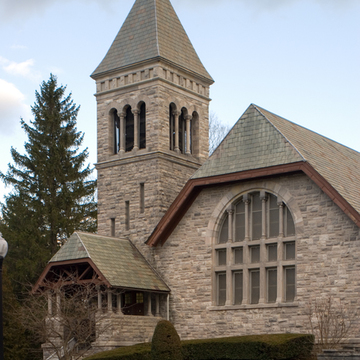Overlooking the Proctor village square, the Union Church is a company church in a company town. In 1871 Redfield Proctor selected this mill village at Sutherland Falls on Otter Creek in Rutland Town as the center for regional marble operations, consolidating them into what would become the world's largest marble company. The Vermont Marble Company emerged in 1880 with a series of major government and public commissions, beginning with the Indiana State Capitol of 1881 and fed by Proctor's political connections as governor (1879–1880), secretary of war (1889–1891), and U.S. senator (1891–1908). So important was the company to the village's fortunes that in 1882 it was renamed Proctor. In 1886, in reaction to political victories by the Knights of Labor in Rutland, Proctor achieved partition as an independent town. As the mills expanded between the 1880s and 1920s, the population grew with skilled and unskilled immigrant workers occupying a company-built town fabric. The corporation and the Proctor family financed neighborhoods of worker housing, and built corporate headquarters, schools, hospital, workers' club, store, bank, library, monumental marble bridge, and this church, designed and built by mill superintendent Patch.
The church is basically Romanesque Revival, a substantial L-shaped building wrapped around a corner tower with an arcaded belfry and a slightly flared hipped cap. It is built of rock-faced gray marble with red-tinted mortar. A great, mullion-divided arched window dominates the principal facade, and side windows have lintels carried on marble colonnettes, some beneath relieving arches with checkerboard ashlar tympana. Heavy slate jerkinhead roofs settle over the main block and a deep columnar porch with finely carved capitals. With shaped and exposed rafter tails and timbering, the roof introduces an Arts and Crafts note, as do Tiffany windows that depict the seasons and are dedicated to members of the Proctor family. Patch's work continued to develop in this direction, and he built himself a distinctive Arts and Crafts bungalow in Rutland (RU27) as well as a small parish house next door to this church about 1915.









